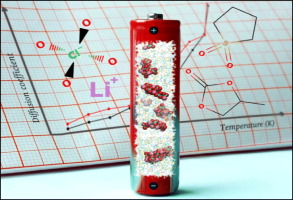Journal of Molecular Liquids ( IF 6 ) Pub Date : 2020-01-21 , DOI: 10.1016/j.molliq.2020.112536 Thejus R. Kartha , Bhabani S. Mallik

|
A mixture of 0.5 M LiClO4 in 80% tetramethylsulfone (TMS) and 20% propylene carbonate (PC) was investigated through classical molecular dynamics simulations to understand properties that could make this a possible candidate for a better electrolyte for lithium-ion battery. The structural analysis through radial distribution function (RDF) reveals the strong interactions between Li+ and ClO4− ions, which increase with the increase in temperature. The interaction between the cation and the solvent molecules is found to be weaker than the cation-anion interactions. However, with an increase in temperature, the cation-TMS interactions decrease while the cation-PC interactions increase. There are prominent, sharp peaks in RDFs, which indicate an aggregating character of the ions in the system with pronounced effects in transport properties. The increase in temperature suggests a faster formation of these aggregates. The ions in this system show moderate ion transport and ionic conductivity. The obtained theoretical results were compared with the experimental data at the reported temperature. The value of correlated conductivity (0.24 mS cm−1) is in good agreement with the experimental (0.21 mS cm−1) results of 0.5 M LiClO4 in PC. Ionic conductivities were calculated for the various temperatures; it increases with increase in temperature. Conductivity calculated by either method shows Arrhenius behavior; the activation energy for ionic conduction is also discussed. From the dielectric calculations, it is observed that the dielectric constant of TMS decreases with an increase in temperature; this is the reason for the increased aggregating character of entities as the temperature increases. The model used in this study also provided values for the dielectric constant that was not very deviating from the experimental results. Understanding this feature, we also propose the concentration of electrolyte that shows enhanced conductivity by changing the TMS-PC proportions in the mixture.
中文翻译:

再次将LiClO 4用作锂离子电池的电解质:聚集行为对离子对动力学和电导的影响
通过经典的分子动力学模拟研究了在80%的四甲基砜(TMS)和20%的碳酸亚丙酯(PC)中的0.5 M LiClO 4混合物,以了解可以使其成为锂离子电池更好电解质的可能的特性。通过径向分布函数的结构分析(RDF)揭示了锂之间的强相互作用+和C10 4 -离子,随着温度的升高而增加。发现阳离子和溶剂分子之间的相互作用弱于阳离子-阴离子相互作用。然而,随着温度的升高,阳离子-TMS相互作用减少而阳离子-PC相互作用增加。RDF中存在突出的尖锐峰,表明系统中离子的聚集特征,对传输性能产生明显影响。温度升高表明这些聚集体形成更快。该系统中的离子显示出适度的离子传输和离子电导率。将获得的理论结果与报告温度下的实验数据进行比较。相关电导率值(0.24 mS cm -1)与实验值(0.21 mS cm-1)在PC中得到0.5 M LiClO 4的结果。计算了各种温度下的离子电导率;它随着温度的升高而增加。两种方法计算出的电导率均显示出阿累尼乌斯行为;还讨论了离子传导的活化能。从介电计算可知,TMS的介电常数随温度的升高而降低;这就是随着温度升高实体聚集特性增加的原因。本研究中使用的模型还提供了介电常数的值,该值与实验结果相差不大。了解此功能后,我们还建议通过改变混合物中TMS-PC的比例来提高电导率的电解液浓度。


























 京公网安备 11010802027423号
京公网安备 11010802027423号